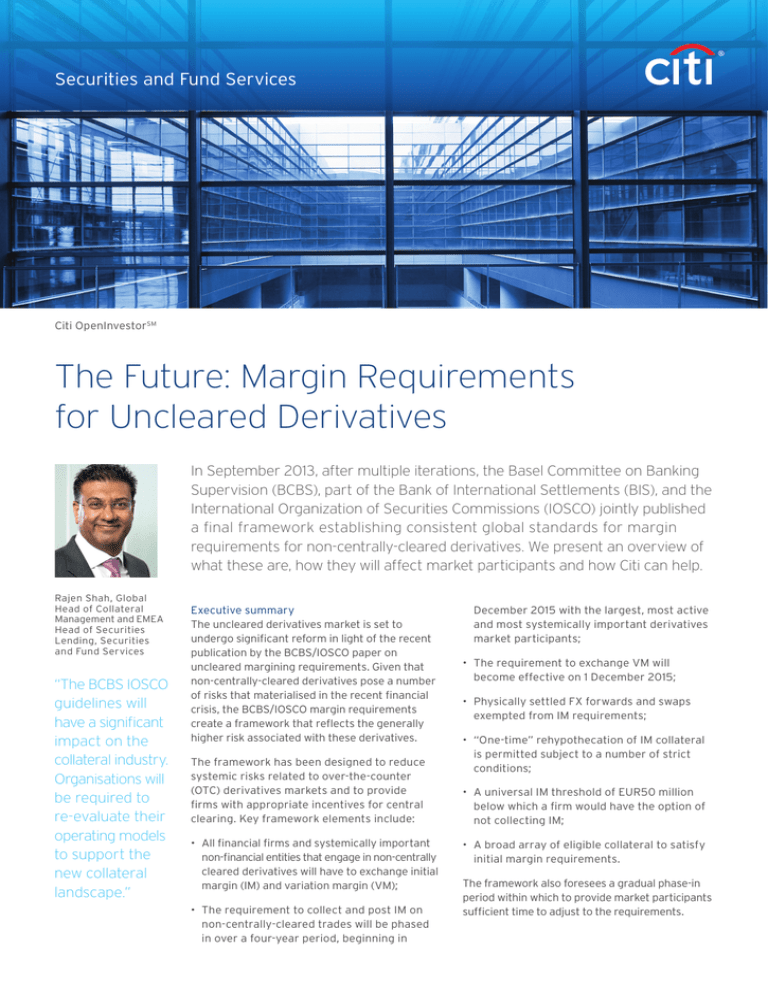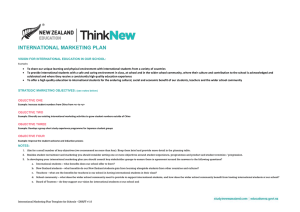
Securities and Fund Services
Citi OpenInvestorSM
The Future: Margin Requirements
for Uncleared Derivatives
In September 2013, after multiple iterations, the Basel Committee on Banking
Supervision (BCBS), part of the Bank of International Settlements (BIS), and the
International Organization of Securities Commissions (IOSCO) jointly published
a final framework establishing consistent global standards for margin
requirements for non-centrally-cleared derivatives. We present an overview of
what these are, how they will affect market participants and how Citi can help.
Rajen Shah, Global
Head of Collateral
Management and EMEA
Head of Securities
Lending, Securities
and Fund Services
“The BCBS IOSCO
guidelines will
have a significant
impact on the
collateral industry.
Organisations will
be required to
re-evaluate their
operating models
to support the
new collateral
landscape.”
Executive summary
The uncleared derivatives market is set to
undergo significant reform in light of the recent
publication by the BCBS/IOSCO paper on
uncleared margining requirements. Given that
non-centrally-cleared derivatives pose a number
of risks that materialised in the recent financial
crisis, the BCBS/IOSCO margin requirements
create a framework that reflects the generally
higher risk associated with these derivatives.
The framework has been designed to reduce
systemic risks related to over-the-counter
(OTC) derivatives markets and to provide
firms with appropriate incentives for central
clearing. Key framework elements include:
• All financial firms and systemically important
non-financial entities that engage in non-centrally
cleared derivatives will have to exchange initial
margin (IM) and variation margin (VM);
• The requirement to collect and post IM on
non-centrally-cleared trades will be phased
in over a four-year period, beginning in
December 2015 with the largest, most active
and most systemically important derivatives
market participants;
• The requirement to exchange VM will
become effective on 1 December 2015;
• Physically settled FX forwards and swaps
exempted from IM requirements;
• “One-time” rehypothecation of IM collateral
is permitted subject to a number of strict
conditions;
• A universal IM threshold of EUR50 million
below which a firm would have the option of
not collecting IM;
• A broad array of eligible collateral to satisfy
initial margin requirements.
The framework also foresees a gradual phase-in
period within which to provide market participants
sufficient time to adjust to the requirements.
2
Framework background
The fallout from the recent financial crisis demonstrated
a number of weaknesses in the OTC derivatives markets.
Since 2009, G20 countries have embarked on a regulatory
reform agenda focusing on mitigating systemic risk posed
by OTC derivatives practices. In 2011, the G20 requested
the BCBS and IOSCO to develop a consistent global set of
standards for uncleared margin requirements, culminating
in the publication of a final framework in September 2013.
A key feature of the framework is the requirement for all
financial firms and systemically important non-financial
entities to exchange IM and VM to mitigate counterparty
credit risk arising from OTC transactions.
The importance of the framework to the financial
markets cannot be underestimated. The size of the
uncleared universe is substantial, with a significant
portion of the derivatives market not cleared due to lack
of standardisation, liquidity and customisation. ISDA
estimates the size of the uncleared market to be in the
region USD127 trillion.1
Framework objectives
The framework is designed to reduce systemic risks
in the OTC derivative markets and provide firms with
appropriate incentives for central clearing. It should be
noted that the margin requirements are not meant to be
regulations but rather a structure that provides guidance to
national regulators in implementing the G20 commitments
for uncleared derivatives. It achieves this through the
articulation of key principles and requirements as outlined
in the eight elements following.
8 key elements that the framework addresses
1. Appropriate margining practices should be in place
for all derivative transactions that are not cleared by
central counterparties (CCPs).
2. All financial firms and systemically important
non-financial entities must exchange IM and VM
as appropriate.
3. The methodologies for calculating IM and VM should be
i) consistent across covered entities; and ii) ensure that
all counterparty risk exposures are covered with a high
degree of confidence.
4. Assets collected as margin should be highly liquid and
should be able to hold their value in a time of financial
stress (e.g. cash, government and central bank securities,
corporate bonds, covered bonds, gold and equities).
5. Gross IM should be exchanged by both parties and held
in such a way as to ensure that i) the margin collected
is immediately available to the collecting party in the
event of the counterparty’s default and ii) the collected
margin must be subject to arrangements that fully
protect the posting party.
6. Transactions between a firm and its affiliates should
be subject to appropriate regulation and in a manner
consistent with each jurisdiction’s legal and regulatory
framework.
7. Regulatory regimes should interact to avoid any
duplication in standards.
8. Margin requirements should be phased in over an
appropriate period of time, between December 2015
and December 2019, to ensure appropriate transition.
Framework phase-in schedule
Average notional at
consolidated group3
>EUR3tr/USD2.2tr
Exchange of IM
(with EUR50m or
USD36.7m threshold
for covered entities)
2014
2015
2016
2017
2018
2019
Not required
>EUR2.25tr/USD1.65tr
>EUR1.5tr/USD1.1tr
>EUR0.75tr/USD0.55tr
>EUR8bn/USD5.87bn
Exchange of VM
by covered entity2
Agreed as per private bilateral negotiation
Go-live
1 Dec 2015
Indicates date of 1 December for each consecutive year.
1
Initial Margin for Non-Centrally Cleared Swaps: Understanding the Systemic Implications, ISDA November 2012.
Exchanging VM between covered entities only applies to new contracts entered into after 1 December 2015; contracts entered into prior to 1 December 2015 will be
subject to bilateral agreement.
2
All outstanding transactions will be included in the IM calculation.
3
3
Example of IM start date: calculation timeline
The timeline below illustrates the steps required to determine the start date of gross IM obligations.
June 2015
July 2015
August 2015
December 2015
• Calculate month-end notional for June, July and August.
• Where month-end average notional for the 3 months exceeds the threshold, IM obligations will
commence the following December.
• Start gross IM posting.
• The average notional calculation is performed at a consolidated group level and includes physically
settled FX forwards and swaps along with all other OTC derivatives.
Framework timelines
The framework will be phased in over a number of years
to allow market participants sufficient time to adjust to
the requirements. The Key VM and IM requirements:
Variation margin
All covered entities will be required to exchange variation
margin on new contracts entered into after 1 December 2015.
Initial margin
IM will be phased in over a four-year period, beginning in
December 2015. Participants with a derivatives portfolio
over EUR3 trillion/USD2.2 trillion will be first, finishing in
2019 with portfolios of EUR8 billion/USD5.87 billion in size.
Framework implementation
National regulators will be tasked with translating the
framework into a series of rules that will become binding
for market participants.
The expectation is that US regulators will work to issue
final rules in the coming months. In Europe, the standards
will be implemented in EMIR via supplementing rules
called Regulatory Technical Standards (RTS), which
will be drafted by the European Securities and Markets
Authority (ESMA) and approved by the EU Commission.
While there is a risk of regulatory arbitrage, the
expectation is that both organisations will work closely
together to ensure a harmonised set of legislation.
In APAC, national regulators are expected to
align themselves with the framework principle to
promote equivalent and comparable rules to other
regulators. Detailed implementation approaches
have not yet been defined at national levels given the
effective time horizon for the rules. Nevertheless,
the rules will be rolled out and become enforceable
consistently with major western jurisdictions,
limiting the room for arbitrage opportunities.
4
Key requirements
The table below outlines the key margin requirements that firms will need to support along with likely implications.
Elements
Key requirements
Impact
Implications
Scope of coverage –
instruments subject
to the requirements
Initial margin (IM) and variation margin
(VM) requirements apply to all trades
except physically settled FX.
Low
• Many market participants do not
collateralise short-dated FX.
• Relatively simple to remove FX from
exposure calculation.
Forwards and swaps subject to national
guidelines or regulation.
Scope of coverage –
scope of applicability
• Applicable to all financial firms and
systemically important non-financial
entities.
• FX market has already established
industry-wide mechanisms to mitigate
settlement risk through continuous
linked settlement (CLS).
High
• Excludes central banks, sovereigns,
multilateral development banks, BIS
and non-systemic, non-financial firms.
• Daily margining may be onerous for
certain smaller firms as not all have
infrastructure and capacity to manage
daily collateral process.
• Gross IM will have significant impact
to funding, liquidity, systems and legal
documentation.
• VM to be collateralised on a regular basis
(i.e. zero threshold and daily frequency).
• Many buy-side portfolios are directional
and will attract high IM requirements.
• Initial margin with a threshold not to
exceed EUR50 million/USD36.7 million,
applied at the consolidated group level
of an entity.
• Minimum transfer amounts not to
exceed EUR500,000/USD367,215.
• A minimum level of EUR8 billion/
USD5.87 billion of derivatives activity
necessary for covered entities to be
subject to the initial margin requirement.
Baseline minimum amounts
and methodologies for IM
and VM
A combination of standard- and/or modelbased IM methodologies can be used
• The IM baseline should reflect a plausible
increase in the mark-to-market consistent
with a one-tailed 99% confidence interval
over a 10-day horizon.
• IM quantitative models are to be
approved by the relevant supervisory
authorities.
• Quantitative IM models are subject to
internal governance processes.
• IM models may account for
diversification, hedging and risk offsets
within well defined asset classes such
as currency/rates, equity, credit or
commodities, but not across such asset
classes and provided these instruments
are covered by the same legally
enforceable netting agreement.
• Parties to derivative contracts should
have rigorous and robust dispute
resolution procedures.
High
• Challenges in supporting the
model-based approach may result
in organisations using the less risksensitive standard approach resulting in
increased margin requirements.
• UCITS funds are required to have an
independent valuation process, which
may result in using the standardised
approach for ease of calculation.
• There are potential difficulties in
resolving disputes where both parties
are using different, prudentially
approved models.
5
Elements
Key requirements
Impact
Implications
Eligible collateral for
margin
National supervisors are to develop their
own types of eligible collateral that would
generally include:
Medium
• The costs of assets considered eligible
for collateral are like to increase
significantly due to an increase in
demand.
• Cash
• Firms may be increasingly reliant
on transformation services given a
shortage of eligible assets.
• High-quality government and central
bank securities
• High-quality corporate bonds
• High-quality covered bonds
• Equities included in major stock indices
• Gold
Treatment of provided
initial margin
The rehypothecation of customer
collateral is permitted subject to
restrictive conditions:
High
• G
ross IM will result in a significant
increase in funding requirements.
• S
ignificant legal documentation will
be required to support new gross
IM construct, including ISDA 2013
Account Control Agreement supporting
the segregation of independent
amounts for uncleared swaps with an
independent third-party custodian.
• Only permitted for hedging collector’s
derivatives position.
• Can only be rehypothecated once.
• Must be segregated throughout
the chain.
• Pledgor to be notified and protected
against loss.
• C
ustomer collateral defined as buyside/non-financial institutions.
Treatment of transactions
with affiliates
Determining IM and VM requirements for
transactions between affiliates should be
the responsibility of local supervisors.
Low
Many organisations currently collateralise
intragroup exposures to minimise
regulatory capital requirements.
Phase-in of requirements
VM requirements are effective
1 December 2015
High
Gross bilateral exchange of margin is not
common market practice:
• They are applicable to new contracts
entered into after 1 December 2015.
• Two-way IM with a threshold of up to
EUR50 million/USD36.7 million will be
phased in commencing in 2015.
• Significant business, operational and
technical complexities of posting IM need
to be addressed on an industry scale.
• There is limited time between the
determination of whether parties are in
scope and the go-live.
6
Bifurcation of netting sets
Systems will need to be configured
to support multiple collateral
requirements. Netting sets will continue
to be bifurcated further exacerbating
funding and liquidity obligations.
Client
Current CSA
(Pre-BCBS/IOSCO)
BCBS/IOSCO CSA
OTC cleared
arrangements
CCP1
Organisational challenges
The Impact of two-way gross IM
Two-way margining will result in many OTC market participants
making significant investments in their collateral infrastructures
and capabilities. Given that two-way exchange is not
common market practice today, the posting of IM between
counterparties who have never done so is likely to be complex
and require significant legal and operational analysis including:
• Collateral control agreements will need to be negotiated
with third-party custodians. Connectivity to multiple custodians
will be required to manage the segregated IM;
• New process and controls will be required to support
the rehypothecation requirements;
• Systems will need to be configured to support the revised
margin calculation and account segregation requirements.
Many applications only support unilateral IM, not bilateral IM;
• Reporting will need to be significantly enhanced to track collateral
assets and identify ultimate hypothecation beneficiaries.
Account control agreements (ACAs)
Segregated custody accounts will be required to hold cash and
securities pledged as IM. Under the ACA, the custodian acts as
an intermediary between the pledgor and the secured party,
holding collateral in the name of the pledgor for the benefit
of the secured party in a segregated custody account. While
triparty agreements are not uncommon, added complexity will
arise as both parties will need to have made arrangements to
support the gross bilateral IM requirement, where:
• Substitutions will be more challenging to support given
involvement of multiple parties.
• Enhanced reporting will be required to get visibility of
collateral positions and collateral values.
• Connectivity to numerous custodians will be needed as
each party will use their preferred custody arrangements.
CCP2
Standard CSA 2013
CCP3
Supporting multiple collateral arrangements
Many firms may be required to support multiple collateral
arrangements per counterparty. Given the framework
only applies to trades executed after 1 December 2015,
organisations may need to support pre- and post-BCBS/
IOSCO CSAs. This is likely as current CSAs are less
punitive than those required by BCBS/IOSCO, resulting in
organisations maintaining them for as long as possible.
Moreover, the clearing obligation will require addtional
collateral arrangements, further increasing complexity.
Limited rehypothecation
While previous iterations of the framework did not permit
rehypothecation, the final framework recognises the
possible liquidity and funding impact of such a requirement.
As such, the framework allows the rehypothecation of
customer collateral, subject to restrictive conditions
and only for the purpose of hedging customer positions.
The definition of “customer” is limited to “buy-side”
financial firms and non-financial entities, meaning that
collateral collected by dealers or market makers in
the interdealer market may not be rehypothecated.
Organisations will need to assess their business and technology
models to ensure the rehypothecation requirements can be
effectively supported. Developing mechanisms that ensure
hypothecation compliance will be key.
Given the likely impact, what can organisations do now?
On a number of functions and disciplines across an
organisation, a combination of technical, financial,
operational and legal analyses will be required to accurately
identify areas that will be most affected. Organisation
should look to conduct the following initiatives:
Compliance date evaluation
Calculating the average notional size of current and
future portfolios will provide an indication as to when
organisations will need to comply with the framework.
7
What can be concluded?
Supporting the final framework will require organisations
to make considerable investments in their collateral
infrastructure and technology. Furthermore, the liquidity,
capital and balance-sheet implications generated by IM
requirements will need to be understood and quantified
and form part of an organisation’s collateral strategy and
decision-making.
Funding impact assessment
Organisations should calculate the size of exposure to
be collateralised and the associated liquidity impact
using the standard- and model-based approach to clearly
understand best and worst case scenarios. This will
determine whether alternative forms of funding, including
transformation services are required.
Account control agreements feasibility study
Given that the ACA will support gross IM requirements,
organisations need to understand the legal, technical and
operational requirements to support such structures.
Custody arrangement evaluation
Depending on estimated compliance dates, an organisation
should consider assessing its custodian’s ability to support
ACA and the gross segregation of IM.
Organisations will need to conduct assessments of their
collateral functions and infrastructure to ensure they
will comply and that take full advantage of the new
margining framework.
Collateral tracking
Organisations should develop tools that identify and track
collateral across locations, custodians and ultimately the
beneficiaries of hypothecated collateral.
Overview of rehypothecation framework
Rehypothecation of cash and non cash initial margin is permitted on a limited basis and subject to a number of restrictions.
Cash and non cash variation margin may be rehypothecated.
Transaction
1 •
The customer gives their express
consent in writing to rehypothecate,
including the segregation option.
2 •
The IM collected from the customer
is treated as a customer asset, and
is segregated from the initial margin
collector’s proprietary assets.
3 •
4 •
Only buy-side financial firms and non-financial entities collateral is permitted to be rehypothecated.
Margin collected in the interdealer market may not be rehypothecated.
1
Contractual
agreement
Customer
2
IM
The IM collector must require the
third party to segregate IM from
the assets of the third party’s other
customers, counterparties and
proprietary assets, and must prohibit
any further rehypothecation.
4
IM
Initial margin collector
IM prop.
assets
Client assets
Client assets, inc
l. non-rehypo. and
non -seg rehypo.
• Where collateral is rehypothecated,
5
the IM collector must notify the
customer. Upon request and where
IM is segregated, the IM collector
must notify the customer of the
collateral value rehypothecated.
• The IM collector and the third party
must keep appropriate records to
show compliance.
• Levels and volume of
rehypothecation must be disclosed
to the authorities to monitor risk.
• Appropriate controls required to
ensure collateral use would only
allow a one-time rehypothecation.
Client assets
3
Rehypo ISA
Rehypo ISA
rehypothecation
Rehypo ISA
Rehypo ISA
5
The third party must treat IM as
customer assets, and segregate
from the third party’s proprietary assets.
Reporting and control
Third- party customer
Key
Customer
“Buy-side” financial firm non-financial entity
IM Collector
Derivatives market maker
Third party
Third-party customer
Reporting and control
Collateral
Client
assets
Third-party
assets
How can Citi help?
OpenCollateralSM is Citi’s open architecture collateral
management solution designed to help clients optimise
the way they use their collateral and help streamline
the administrative and operational challenges of
managing all types of collateral assets across multiple
counterparties. OpenCollateral runs an integrated,
exception-based margining process that uses
automated communication methods to process margin
calls in a timely way, identify margin discrepancies
early and resolve portfolio reconciliation disputes. The
result is that organisations that use OpenCollateral can
navigate the regulatory landscape with greater control
while they optimise how they manage their collateral.
Account control arrangements
Citi provides segregated custody accounts to hold cash
and securities pledged as IM collateral under an account
control arrangement. Segregated Collateral Custody
Accounts help clients better mitigate counterparty risk,
provide asset safety and improve collateral efficiency.
Assets are held in Citi’s custody, where Citi performs
daily collateral services that incorporate a full eligibility
and haircuts schedule. Citi system functionality ensures
collateral can easily be identified, tracked and monitored,
ensuring its full visibility when being rehypothecated and
the safe-keeping of collateral assets.
Citi OpenInvestorSM is the investment services solution for
today’s diversified investor, combining specialised expertise,
comprehensive capabilities and the power of Citi’s global
network to help clients meet their performance objectives
across asset classes, strategies and geographies. With
an on-the ground presence in over 95 countries and over
USD13.9 trillion in assets under custody, Citi offers awardwinning service and unmatched scale.
Citi also provides complete investment services for
institutional, alternative and wealth managers, delivering
middle-office, fund services, custody, and investing
and financing solutions focused on its clients’ specific
challenges and customised to their individual needs.
For more information
Joseph Tomo
joseph.tomo@citi.com
+1 (212) 816 6951
Karim Chabane
karim.chabane@citi.com
+852 286 86233
Philip Forkan
philip.forkan@citi.com
+44 (0) 20 7986 4991
Collateral optimisation
OpenCollateral also allows clients to smartly and
effectively allocate assets to collateral pools, taking
into account individual client preferences and
quantitative parameters to optimise asset distribution
across all collateral agreements. Those parameters
include asset inventory and collateral available for
rehypothecation, eligibility criteria on all margin
types and counterparties and applicable haircuts.
OpenCollateral can also support the rehypothecation
of collateral and provide comprehensive reporting for
all collateral activities to all parties.
citi.com/securitiesandfundservices
© 2014 Citibank, N.A. All rights reserved. Citi and Citi and Arc Design are trademarks and service marks of Citigroup Inc. or its affiliates,
used and registered throughout the world. The information contained in these pages is not intended as legal or tax advice and we advise
our readers to contact their own advisers. Not all products and services are available in all geographic areas. Any unauthorised use,
duplication or disclosure is prohibited by law and may result in prosecution. Citibank, N.A. is incorporated with limited liability under the
National Bank Act of the U.S.A. and has its head office at 399 Park Avenue, New York, NY 10043, U.S.A. Citibank, N.A. London branch
is registered in the UK at Citigroup Centre, Canada Square, Canary Wharf, London E14 5LB, under No. BR001018, and is authorised and
regulated by the Financial Services Authority. VAT No. GB 429 6256 29. Ultimately owned by Citibank Inc., New York, U.S.A.
GRA24784
01/14





